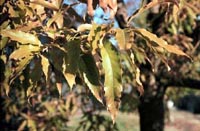Resource Library
Plant of the Week: Sawtooth Oak
The University of Arkansas System Division of Agriculture does not promote, support or recommend plants featured in "Plant of the Week." Please consult your local Extension office for plants suitable for your region.
Plant of the Week
Sawtooth Oak
Latin: Quercus acutissim

It’s hard to live in Arkansas and not think about oaks, especially in the fall. Acorns bong off the roof and drifts of leaves accumulate as we mentally prepare for the task of leaf removal that lies ahead.
With more than 40 species of native oaks already growing in the state, it seems unlikely that a foreign oak would find a niche in our landscapes, but one has; the sawtooth oak (Quercus acutissima).
The sawtooth oak is a medium size tree growing to 50 feet tall with a broad, rounded form at maturity. Young trees grow quickly with lowest branches tending to spread widely if not pruned off at an early age. The sawtooth oak is fast growing for an oak, reaching 30 feet in 15 years.
Sawtooth oak leaves are unlike the leaves of our native oaks. Looking much like those of the Chinese chestnut, they are about 6 inches long, unlobed and oblong in outline with the tip tapering to a fine point. Leaf margins are reminiscent of a saw blade and terminate in a fine bristle. Because of the bristle, the sawtooth oak is considered a member of the red oak tribe.
Part of the beauty of sawtooth oak is the clean, glossy appearance of the foliage. The foliage is unblemished and glossy-green all summer long. In the fall, it turns yellow, finally aging to grocery-bag brown. Young trees tend to hold much of their foliage through the winter, shedding it in the spring as new leaves emerge.
Though the leaves look decidedly un-oak-like, the appearance of the acorns in the fall definitely identifies this tree with the oaks. It produces heavy crops of 3/4 inch round, brown acorns that will cover the ground in many years. It is the first oak to drop its acorns in the fall, usually about three weeks ahead of its native kin. The cap of the acorn covers about half of the nut and reminds me of bowl-cut hairdo that is badly in need of a trim.
The sawtooth oak is native over a wide range in Japan, Korea and China. It was introduced into the U.S. in 1862 but remained almost unknown until its ability to produce heavy crops of acorns was realized.
Heavy acorn production, even though it tends to occur in alternate years, makes the tree valuable as a wildlife food plant. Deer especially seem to relish the acorns. During the 1980s and 90s, sawtooth oaks were distributed as part of the "Acres for Wildlife" program sponsored by the Arkansas Game and Fish Department. The trees that now are showing up in front yards and woodlots across the state are from these seedlings.
The sawtooth oak is hardy statewide and seems unbothered by any serious insect or disease problems. Being a large tree at maturity, it should be planted where it has sufficient room to spread. It is not picky about soil type, but faster growth will be realized in better soils. It seems to have excellent drought tolerance once established.
By: Gerald Klingaman, retired
Extension Horticulturist - Ornamentals
Extension News - October 18, 2002
The University of Arkansas System Division of Agriculture does not maintain lists of retail outlets where these plants can be purchased. Please check your local nursery or other retail outlets to ask about the availability of these plants for your growing area.